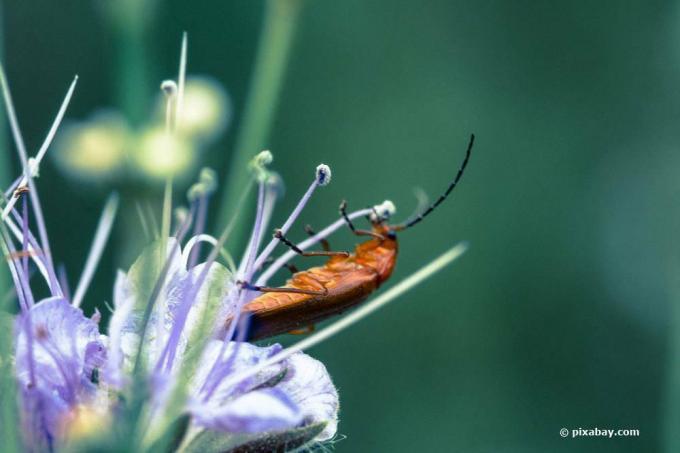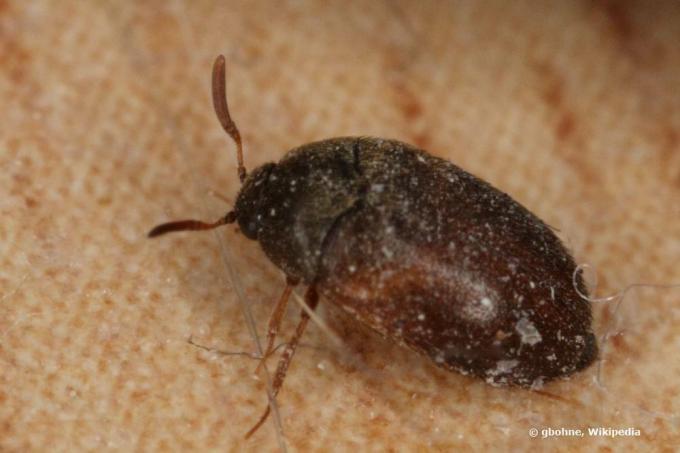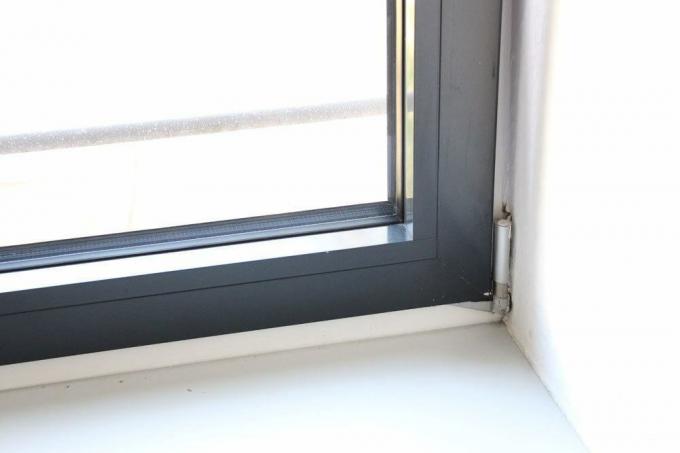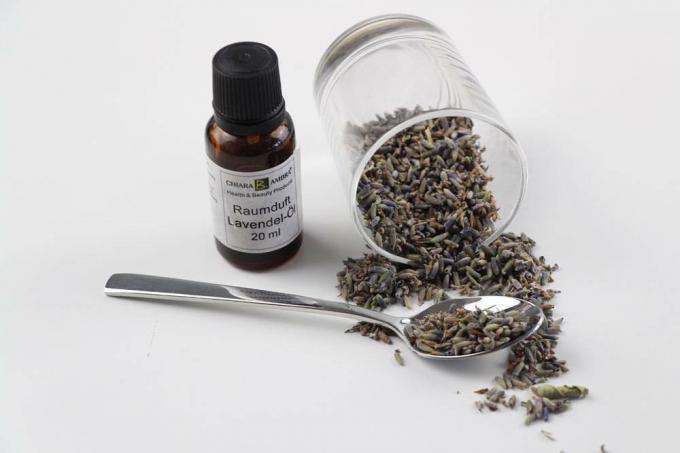
table of contents
- Brown beetle
- Brown fur beetle
- Parquet beetle
- Weevil
- Bread beetle
- Grain beetle
Suddenly, for no apparent reason, they are there. Small brown beetles that spread around the house and apartment. The kitchen, pantry, houseplants and cracks in the floor are some of her favorite hiding spots. Assigning the pests is often not that easy, because the pests are only a few millimeters in size. But it is necessary for effective control, because we only think “The great crawling” is great in the animated film of the same name. We have put together here how you can identify and combat the pests.
Brown beetle
There are countless brown beetles in the insect kingdom. The following beetles like to move into the house or apartment.
- Brown fur beetle
- Parquet beetle
- Weevil
- Bread beetle
- Grain beetle
The beetles prefer food, plants or textiles, depending on the species. Even if you only find a single one of these beetles, you should immediately take appropriate control measures.
Brown fur beetle
The brown fur beetle, Attagenus smirnovi, originally comes from Africa, but was discovered in Germany as early as the mid-1980s. It is a typical textile pest.
Appearance
- elongated to oval
- Length: 3 to 5 millimeters
- Width: 2 to 2.5 millimeters
- Dark red to black head, rest of body somewhat lighter
- yellow to light brown, hairy wings
- red-yellow antennae and legs

Eating behavior
The brown fur beetle prefers pelts, hides and wool. Above all, he loves wool in every kind, so woolen sweaters and scarves are just as much on his menu as the carpet in the living room. You can recognize an infestation by small holes in the textiles.
Popular places
In addition to the wardrobe and other woolen items, the pest can often be found on window sills. In contrast to its larvae, the adult beetle is drawn to light. Since it likes to lay its eggs in cracks in parquet and other wooden floors, apartments with such floors have a special attraction for the fur beetle. Nothing is known about an infestation at a certain time of the year. It can penetrate your apartment or house at virtually any time.

Propagation and larvae
The female fur beetles lay between 50 and 60 eggs, preferably in the cracks of wooden floors. There the beetle's larvae find enough food, such as fallen hair. But wool items are also on the larvae's menu. Textiles that are kept in a chest for a long time are particularly at risk: an ideal place for the larvae because it is dark and they can also find enough food here. The larvae avoid the light and stay there until they transform into a beetle, hidden in the dark. After six to eighteen months, the egg has become a reproductive fur beetle.
The larvae have the following appearance:
- up to 8 millimeters long
- Bristle tail at the end
- Bronze brown to gold in color
- Body segments with ribbed, lanceolate scale bristles
Combat
For effective control, the starting point of the infestation must first be determined. You can recognize the infestation by small holes in the material.
Find larvae:
- in all articles made of wool, including in the wardrobe
- in furs and skins
- in cracks and crevices in wooden floors
- in gaps such as between the carpet strip and the floor
- in storage spaces such as boxes or chests
Tip: The pest can also nestle in the sheepskin of the stroller. A thorough search is therefore essential.
Infested textiles
Heavily infested textiles can no longer be saved. These must be disposed of immediately. For other, infected pieces, proceed as follows for the rescue.
- Heat infected textiles to 60 degrees Celsius
- "Treat" for at least one hour in the oven or in the dryer
- Heat kills eggs, larvae, pupae and adult fur beetles

Tip: Dryer or Thoroughly clean the oven after the process. Mothballs and paper also help against the pest.
Floors and floorboards
The good news first: you don't have to renew the floor. But it must be cleaned thoroughly.
- Vacuum cracks and crevices in a targeted manner
- then seal cracks and crevices with silicone

The larvae can no longer find food in the wooden floor. And hair or fluff can no longer collect in the closed cracks.
Tip: Animal hair is also on the pest's menu. Pet owners should therefore pay particular attention to fallen hair.
Preventive measures
The brown fur beetle does not like the smell of essential oils. You can protect your textiles with lavender flowers or with untreated, red cedar wood.

Parquet beetle
The parquet beetle, Lyctus linearis, targets wooden furniture and parquet floors. Fresh wood, on the other hand, does not interest him at all.
Appearance
- Length: 2.5 to 5 millimeters
- red-brown to black-brown body
- Head clearly visible
- Pronotum with longitudinal oval furrow
- dotted and hairy wings
- special feature: small tooth in front of the antennae root on the head

Eating behavior
The actual pests here are the larvae, because they eat the wood.
Propagation and larvae
The females lay their eggs between April and August. The angel-like larvae then eat their way through the wood. They leave behind light and very fine drill dust as a trace. An infestation can also be seen in tiny holes. They arise when the finished beetles leave the wood.
Combat
In order to combat the parquet beetle effectively, the wood must be thermally treated. This is not possible in private households. The affected parquet parts should be replaced here.

Tip: Use special traps to check whether it is actually a parquet beetle infestation before replacing the floor.
Weevil
The weevil, Curculionidae, is a plant pest. Although the 1,000 or so species specialize in different plants, the voracious pest no longer stops at any plant. Orchids and cardiac plants are still considered safe from the beetles.
Appearance
- Length: up to 20 millimeters
- light gray to brown color
- Proboscis is a special feature

Eating behavior
The adult beetles feed on the leaves of the plant and leave rounded feeding tracks there. The real and far greater danger, however, is the larvae of the weevil. They feed on the roots of the plants. If the plant leaves the leaves drooping, even with proper care, weevil larvae may be in the ground. If no countermeasures are taken, the leaves will dry up and ultimately the plant will perish.
Popular places
Adult weevils like to settle around the plant. During the day, the beetles are often not noticeable because they are nocturnal and hide during the day. Popular hiding places for light-shy insects are branches of plants, such as the root house. But they are also happy to look for shelter between the flower pot and translator, i.e. practically all places around the plant that are dark.
Weevils come into the house or apartment from outside. They often move from trees in the garden, but also from trees in avenues in streets, to our living spaces. They, or better the eggs and larvae, can, however, also be introduced into your own four walls with new plants.

Propagation and larvae
During the breeding season in spring and at the end of summer, a female weevil lays up to 1,000 eggs in the ground. The small, white larvae hatch after about three weeks. Since the larvae are in the ground, they are very difficult to spot. A whole generation is passed through each year, i.e. the first young beetles break free from the pupal shell in April.
Combat
In order to effectively control the weevil, its reproduction must be interrupted. It is best to catch the nocturnal insects when it gets dark. Then go looking for it with a flashlight.
- detected bugs pretend to be dead
- easy collection possible
In addition to nightly searches, you should set up special weevil traps. You can trick the pest with a wood wool trap.
- Fill the flower pot or nursery pot with wood wool or straw
- place near the infected plant
- Empty the trap when it is bright and destroy beetles

Tip: You can also use a simple wooden board as a bug trap. The aim is to offer the beetle a dark hiding place.
Larva control
To stop the pest infestation, you should also fight the larvae of the weevil. The use of HM nematodes is very effective as they do not harm plants, pets or humans. The roundworms that the beetle's larvae eat are brought out with a special nematode syringe.
Bread beetle
The bread beetle (Stegobium paniceum) targets supplies in the house or apartment. It specializes in starchy food, but also eats plant-based building materials such as wood, which can also lead to structural damage.
Appearance
- oval body
- Length: around 3 millimeters
- reddish brown color
- Hair on the top
- Breastplate encloses the head like a hood
- the last three parts of the antennae are thicker

Eating behavior
Bread beetles feed on dry foods. Their menu includes pasta, rice and, as the name suggests, hard bread, such as crispbread. But also chocolate, soup cubes or even chili powder taste good to omnivores. And when he runs out of food, he even eats books and documents.

Popular places
The bread beetle likes to be in the dark and hidden. As a result, it is rarely seen. However, it can also be seen on windows and window sills. This increases the chance of recognizing an infestation. The flyable bread beetles can enter the apartment through the open window. However, they can be brought in with dry foods, spice mixtures or loose tea.
Propagation and larvae
The females of the bread beetle lay up to 100 small, white eggs. They use every crevice, no matter how small, to lay their eggs. The small heaps can even be found between the lid and the jar. The bread beetle generation cycle usually lasts seven months. However, if the beetles find favorable conditions, this cycle can be shortened to two months.
The larvae of the bread beetle also live in the dark, but they give themselves away more easily than adult beetles. Because they spin webs that are easy to recognize in the storage containers, for example for flour or spices. They can also be found in dry bouquets. The larvae themselves are 3 millimeters long and have 6 legs. They pupate in a cocoon made of food and their own droppings.
Combat
Contaminated food must be disposed of immediately. So that the bread beetle cannot spread further via the household waste, you should kill the pests before disposing of them.
- Treat infected food with heat or cold
- Place in a warm room at 60 degrees Celsius for at least an hour (e.g. B. Oven)
- Place in the freezer (-18 degrees Celsius) for at least an hour
Further measures are:
- thorough cleaning of shelves and cupboards
- pay particular attention to cracks and joints
- Remove and replace cabinet paper
- Let the cupboards and shelves dry well
- Clean the outside of the storage container that is not infected

Tip: Pure vinegar can be used for cleaning.
Grain beetle
Dried fruits or dry pasta are also on the menu of the grain beetle, which is next to these foods also from different types of grain, such as oats, barley or maize, nourishes. This is why muesli is one of his favorite dishes.
Appearance
- oval body
- Length: 3 to 5 millimeters
- dark brown color
- special characteristic: trunk

Eating behavior
Adult grain beetles eat dry foods from the outside. Their larvae, on the other hand, eat pasta and other foods from the inside.
Tip: You can easily check for grain weevil infestations in cereal grains. Add a generous amount of grains to a bowl of water. Grain infestation is very likely if the grains are still floating on the surface after stirring.

Popular places
Corn beetles like to be near their food sources. Most of them are discovered after they have already eaten food. Their larvae can be found in the grain or in the noodle. Close relatives of the grain beetle are the rice and corn beetles. These flyable beetles behave similarly to the grain beetle. Therefore, they can be combated with the same means.
Propagation and larvae
The female grain beetle lays up to 200 eggs. When laying eggs, a grain is drilled into for each egg and the egg is placed in it. After the egg has been laid, the grain is closed again with a secretion.
Larvae are:
- are up to 2 millimeters long and
- are soft and white
The grain weevil growth cycle is about a month.
Combat
If a grain beetle infestation is discovered, action must be taken immediately.
- Dispose of contaminated food
- heat the food to 60 degrees Celsius beforehand (oven)
- Thoroughly clean shelves and cupboards
- Vacuuming
Tip: After thorough vacuuming, remove or remove the vacuum cleaner bag. switch.
Pay particular attention to cracks and crevices on shelves and storage cupboards. They are a popular hiding place for the beetles. Therefore, further measures should be taken at these points.
- After vacuuming, heat cracks and crevices with a hairdryer
- Scatter silica or silica in cracks and crevices
Tip: The grain beetle is not harmful to health. If you accidentally eat infected food, it will not harm your health, as the beetles do not transmit any diseases.
